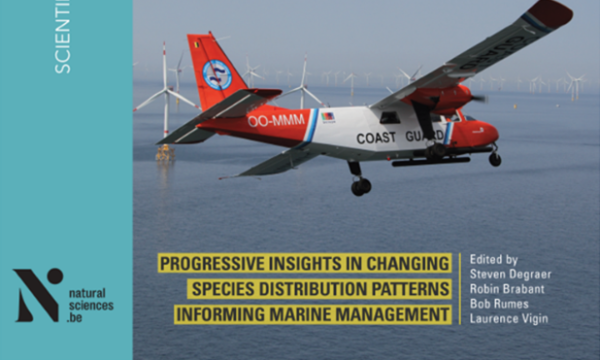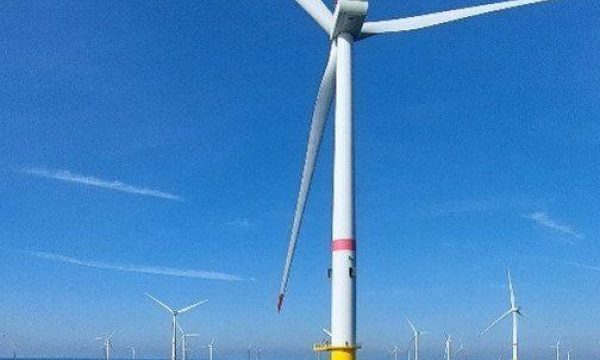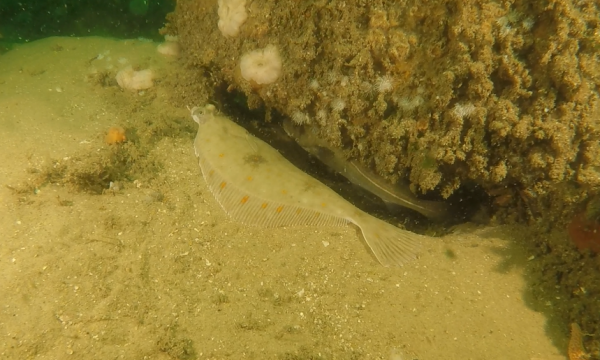General Environmental impacts of offshore wind farms in the Belgian North Sea: Preparing for more offshore wind farms

The scientists monitoring the environmental impacts of offshore wind farms in the Belgian part of the North Sea focus in their latest annual report on the further development of the program and its expansion in the run-up to scaling up wind energy capacity in our waters. Notable results include that no significant impact of wind farms is found on the abundance of invertebrates and fish living on sandy bottoms (no negative impact), that communities of organisms living above the bottom are more diverse in wind farms (positive impact), and that dispersion models now allow determining how many seabirds move as a result of the wind farms (magnitude of impact varies between species, with the greatest sensitivity outside existing and future wind farms). Furthermore, insights on promoting the artificial reef effect and mitigating the risks for bird collision and porpoise disturbance continue to develop.
Since the end of 2020, the number of offshore wind turbines and their combined capacity in the Belgian part of the North Sea has remained unchanged. At that time, 12 years of construction in Belgium's first marine renewable energy zone ended, resulting in eight wind farms with a total of 399 turbines in a 238 km² zone along the border with Dutch waters. Together they account for an installed capacity of 2.26 gigawatts (GW) and an average annual production of 8 TWh, which is about one-third of the gross electricity production from renewable energy sources in Belgium.
Ensuring the environmental sustainability of human activities at sea is an important task for the developing blue economy. Therefore, since the start of construction in 2005, the monitoring program WinMon.BE generates basic ecological information in the Belgian offshore renewable energy zone, focusing on impacts at different spatial and temporal scales. The aim is twofold: to quantify expected and unexpected impacts and to understand cause-effect relationships. The knowledge gained so far led to the adjustment of offshore wind farm construction and operation practices where necessary, thus contributing to the environmental sustainability of wind energy production in the Belgian part of the North Sea. All
scientific reports of the WinMon.BE monitoring zijn openbaar.
Preparing for expansion
In order to meet the EU objective of zero greenhouse gas emissions by 2050, our country plans to add an installed capacity of 3.15 to 3.5 GW by building additional offshore wind farms in a second renewable energy zone - the Princess Elisabeth Zone (285 km²) - designated in the national marine spatial plan 2020-2026 . It goes without saying that the knowledge acquired by WinMon.BE will also be applied to environmentally friendly design and operation of the future offshore wind farms in the Princess Elisabeth Zone.

Renewable energy zones, including offshore wind farms, in the Belgian part of the North Sea. Eastern zone = first phase fully operational, western zone (Hinder North, Hinder South and Fairybank) = Princess Elisabeth Zone (source: Marine Spatial Plan 2020-2026).
However, Belgium is not the only country developing wind energy production in the southern North Sea. In addition to the 523 km² designated for operational and planned offshore wind farms in the Belgian part of the North Sea, 344 km² are planned in the adjacent Dutch Borssele zone, and 122 km² in the French Dunkirk zone. The international expansion also affects the monitoring program.
Steven Degraer (Royal Belgian Institute of Natural Sciences KBIN/MARECO), coordinator of the WinMon.BE consortium: "Because the potential cumulative ecological impacts of the growing number of offshore wind farms in the southern North Sea are a major concern, detecting and understanding them becomes a significant additional challenge for WinMon.BE. We also need to internationalize cooperation in the broader North Sea region, where national borders have prevented a regional approach."
In order to be ready to monitor the environmental impact of the growing offshore wind energy sector in the Belgian part of the North Sea, the WinMon.BE 2022-rapport addresses new insights into invertebrate and fish distribution, identification of areas where seabirds are most sensitive to offshore wind farms, "promoting the good" (colonizing communities of artificial hard substrate) and "mitigating the bad" (seabird collisions and porpoise noise). The report is based on data collected through 2021.
Spatial distribution patterns and vulnerable areas
On the seabed - epibenthos & demersale vissen (ILVO)
To detect and understand effects of the existing offshore wind farms, and to evaluate possible effects of the future renewable energy zone, one must first document and understand the pre-construction situation. For epibenthos (invertebrates living on the seabed, such as certain mollusks, crustaceans and squid species) and benthic fish, a community analysis was therefore conducted for the entire Belgian North Sea. Thus, distribution and abundance of these organisms were checked, and communities of co-occurring species were defined.
This showed that epibenthos and fish communities differ markedly between the coastal zone and the offshore area. Within the coastal zone, two different communities inhabit muddy and sandy sediments, respectively, while offshore communities are also structured by the topography of sandbanks. The existing renewable energy zone thereby largely overlaps with the offshore epibenthos and fish communities, but monitoring between turbines showed no significant effects of the wind farms.
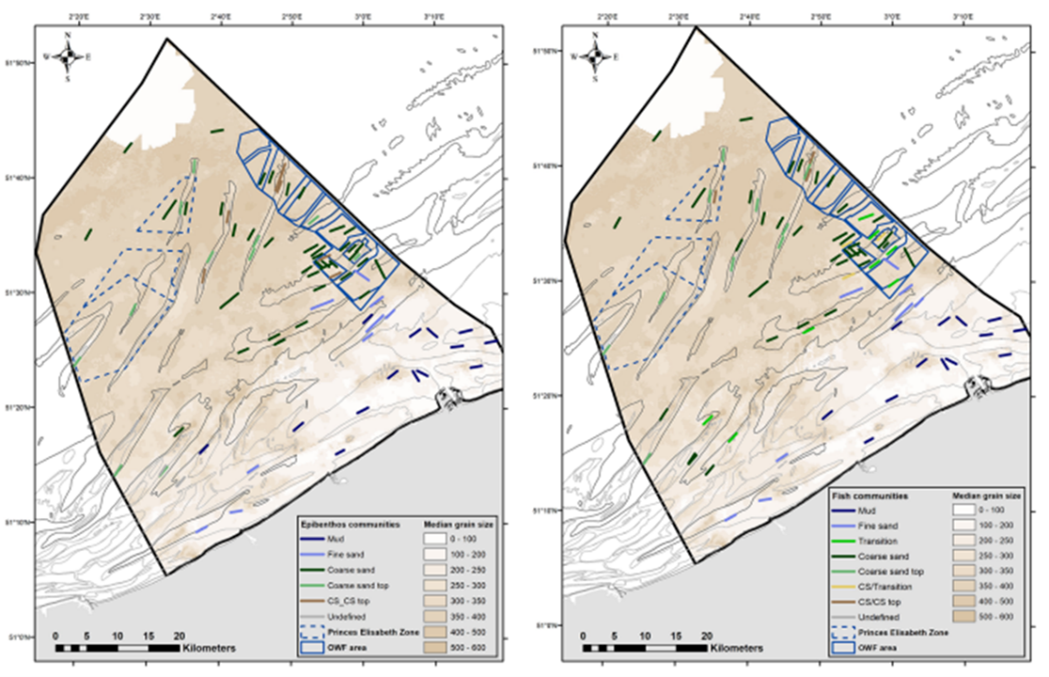
Maps of sampling sites (lines) indicating the epibenthic (left) and fish community types (right) to which they belong: communities of mud and fine sandy sediments in coastal areas (purple shades) and communities of coarse sands further offshore (green and brown shades). © ILVO
Above the seabed – hyperbenthos (Universiteit Gent)
WinMon.BE also focused for the first time on the hyperbenthos. This community consists of organisms inhabiting the water column directly above the seafloor, including a wide variety of small crustaceans and wormids, jellyfish life stages of hydrozoans and larvae of larger crustaceans and fish. The presence of wind turbines (artificial reef effect) and the cessation of fishing (fishery exclusion effect) are expected to result in enriched hyper-benthic communities within the wind farms. To test this, samples collected inside and outside two Belgian offshore wind farms were compared, each with specific local habitat conditions, foundation type, construction time and at different distances from shore.
Although the hyperbenthos communities at different distances from shore were found to differ in species composition (more coastal species closer to shore) and density (higher densities closer to shore), densities were consistently higher in the wind farms compared to the corresponding control sites outside the wind farms. Differences in species richness (higher within the wind farm) and community structure were also observed at greater distances from shore. These results confirm the enrichment hypothesis. Closer to shore, no differences in species richness and community structure were observed.
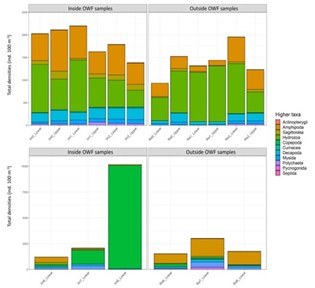
Densities of hyperbenthos inside and outside offshore wind farms. Above = offshore vs. below = coastal zone (different scales, higher densities in coastal zone); left = inside wind farm vs. right = outside wind farm (higher densities inside wind farms). © Ghent University
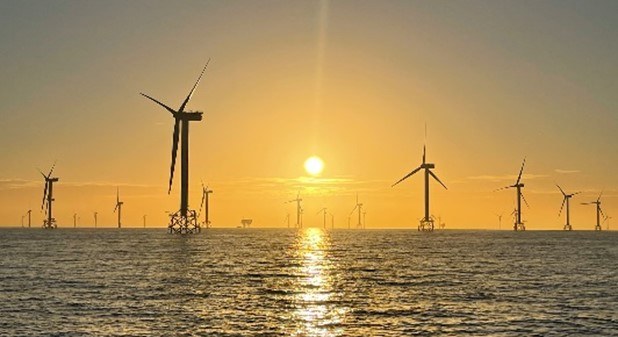
At the surface of the water – seabirds (INBO)
Detailed knowledge of seabird distribution is important to design a monitoring program that gains insight into the sensitivity of different species to offshore wind farms. Based on seabird counts from ships collected in the Belgian North Sea in the period 2000-2018, distribution models were created for four seabird species known to be sensitive to the presence of wind farms: red-throated diver (Gavia stellata), gannet (Morus bassanus), guillemot (Uria aalge) and razorbill (Alca torda). These data were combined into a map (see figure, darker blue indicates higher sensitivity, © INBO) and an integrated index showing where the sensitivity of seabirds to offshore wind farm development is highest.
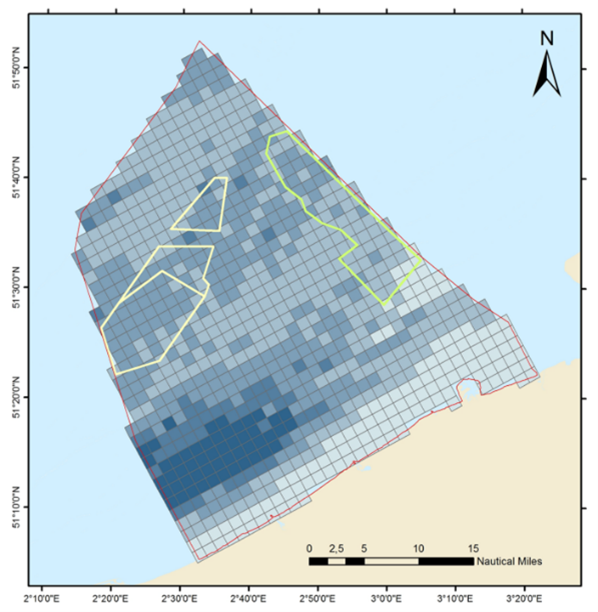
The distribution models also make it possible to quantify the numbers of seabirds whose distributions are expected to shift as a result of the presence of the existing and future wind farms. With approximately 1,600 individuals, guillemot is the most affected species in absolute numbers. One area was identified with respect to seabirds as particularly sensitive to offshore wind farm development. This area lies between 5 and 12 nautical miles from the western part of the Belgian coast, and well outside all existing and future Belgian wind farms.
Promoting the good & mitigating the bad.
"The good" - fouling on foundations (KBIN)
Previous studies have shown that foundations of offshore wind turbines are colonized by a wide range of fouling species (the artificial reef effect). Dominant species at different stages of the colonization process are the anemone Metridium senile, the mussel Mytilus edulis and the crustacean Jassa herdmani. As a result of this colonization, the biomass on the foundations can be up to 35 times higher than on the surrounding soft sediments. However, this higher biomass may affect local food web dynamics, and there are also concerns about the establishment of non-native species (see photo: mussels Crepidula fornicata - arrows, and the mantle Diplosoma listerianum - circle, © KBIN).
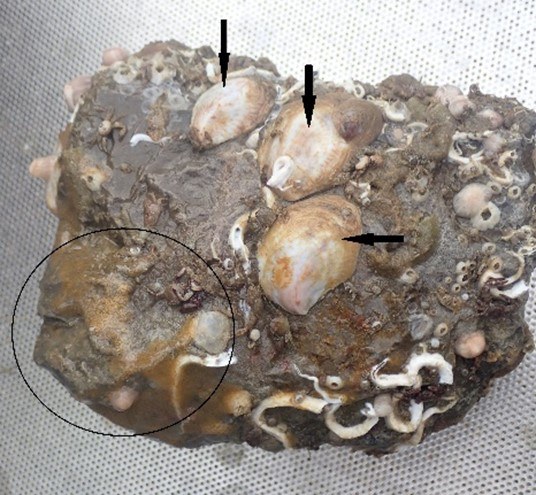
To better understand the potential effects of large-scale colonization of offshore wind turbines by fouling species, the fouling communities on turbine foundations were compared to those on longer-standing artificial hard structures, particularly shipwrecks. The results showed that shipwrecks had higher species richness than offshore wind farms (165 vs. 114 species). Moreover, the species present on the two types of artificial hard substrates were also different: shipwrecks had 95 unique fouling species compared to 44 on offshore wind farms. These differences in species richness can be attributed to the older age and higher structural complexity of shipwrecks. Providing greater structural complexity to and around turbine foundations could increase the species richness of the fouling community, often considered an asset of offshore wind farms.
“The bad” – damage to seabirds (KBIN & INBO)
As offshore wind turbines have a relatively short lifespan, scenarios for replacement are already being discussed for the oldest wind farms. In this regard, technological developments are leading to larger wind turbines with greater open space between them. Meanwhile, the risk of seabird collisions - an important and long-standing problem of offshore wind farms - was evaluated for a hypothetical scenario of replacement of the first offshore wind farm in Belgian waters. For all bird species considered, the estimated collision risk decreased (40% less on average for 15 MW turbines) because of the greater distance between the lower tip of the rotor and sea level and the lower number of turbines per km². Increasing the hub height of the turbines by 10 m further reduced the expected number of seabird collisions by an average of 37%.
Thus, larger turbines may offer an opportunity to reduce seabird mortality. For land birds and bats that also migrate by sea, the effect of larger turbines is less clear. It is likely that strategies involving shutting down turbines at heavy migratory intensity will still be necessary to reduce the effect on these groups.
“The bad” – porpoise disturbances (KBIN, Universiteit Gent & VLIZ)
A second prominent and long-standing problem of offshore wind farms is the disturbance of marine mammals during piling operations, where high impulsive noise levels are produced. Based on passive acoustic monitoring datasets from 2018 to 2020, including the construction periods of three offshore wind farms, it was shown that harbor porpoises (Phocoena phocoena) respond to pile driving over a period of hours to days. Detections of porpoises decreased as far as 20 km from the pile-driving site, with the magnitude and duration of the reduction decreasing markedly as the porpoises moved farther from the source of the disturbance.
The use of noise reduction techniques clearly led to reduced porpoise escape from the construction zone, but the frequency with which porpoises are detected in the immediate vicinity of a construction site appears to decrease even before pile driving. This suggests that efforts to reduce the effect of underwater noise from future offshore wind farm construction on marine life should focus not only on limiting the noise levels generated, but also on the overall duration of construction.

Future research, monitoring and mitigation
Steven Degraer: "Sustaining the effort to accumulate knowledge is necessary not only to further monitor the impact of wind farms already built, but also to refine environmentally friendly design and operation of future offshore wind farms. Significant progress has been made and has proven applicable for proper management of offshore renewable energy. However, many unknowns still need to be addressed."
Some examples of how these ongoing efforts will translate into practice include a greater focus on seafloor invertebrate and fish communities (particularly relevant in the less explored second offshore wind zone), increased sampling efforts to fully characterize hyperbenthos communities and strengthen the statistical ability to detect impacts of offshore wind farms on them, and further refinement of seabird modeling, taking into account additional seabird species and anthropogenic pressures to ultimately inform the marine spatial planning process. Where necessary, mitigation measures should be further designed and implemented as the monitoring program yields new insights.
The WinMon.BE monitoring program is a collaboration between the Royal Belgian Institute of Natural Sciences (KBIN), the Institute for Nature and Forest Research (INBO), the Institute for Agricultural, Fisheries and Food Research (ILVO) and the Marine Biology Research Group of Ghent University, and is coordinated by the Marine Ecology and Management Team (MARECO) of the Royal Belgian Institute of Natural Sciences.
WinMon.BE is conducted on behalf of the federal government in the context of environmental permit conditions for offshore wind farms. For the monitoring the research vessel Belgica (ship time on RV Belgica was made available by BELSPO and KBIN - OD Nature), the research vessel Simon Stevin (operated by the Flemish Institute for the Sea), several private vessels, the Belgian scientific diving team and the observation aircraft of KBIN were used.
